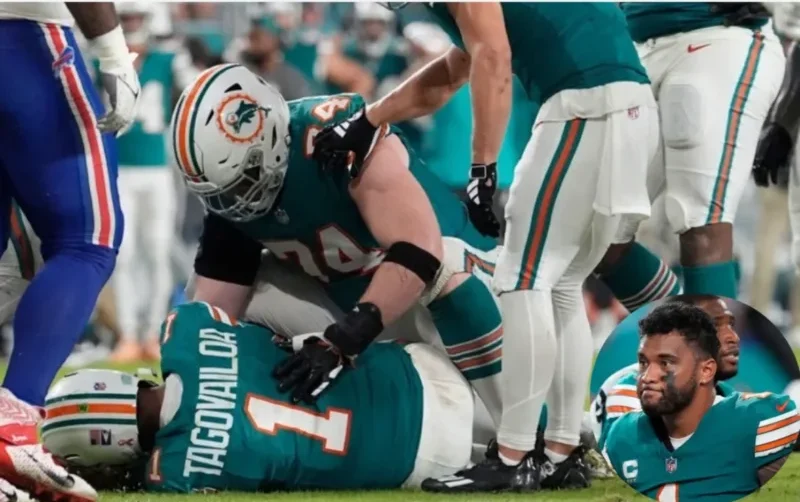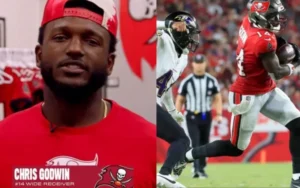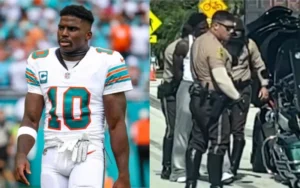In the fast-paced world of professional football, where the stakes couldn’t be higher, a new and heartbreaking episode unfurled last night in the Miami Dolphins-Buffalo Bills rivalry. The teams waged a tense and thrilling battle that, sadly, ended in tragedy for the Dolphins and their embattled quarterback, Tua Tagovailoa. While the Bills may have emerged victorious, the night’s spotlight shone grimly on Tagovailoa and the worrying pattern of head injuries he has sustained in a short time—a development that has triggered panic among Dolphins fans and condemnation of the NFL’s allegedly cavalier attitude toward player safety.
During the third quarter, with the game’s tension at a peak, Tua found himself on a fourth-down play, scrambling for his life and drawing cheers from the crowd. Instead of taking the safe route and sliding to safety, Tua made the hair-raising choice to dive into Damar Hamlin, the safety for the Bills. Tua came out the worse for wear, crumpling to the ground and lying still when the medical staff got to him. No one was behind him in the lineup of people he had to satisfy to stay on the field, and no one was counting on a huge payday because of his success. But in falling to the ground, Tua knocked something loose in the way of his future.
Tua finally stood up and walked to the locker room. For fans and teammates, that was a relief. But was Tua hurt worse than anyone realized? The Dolphins’ star quarterback had just been concussed in what was becoming a too-familiar pattern of behavior for him lately. Mike McDaniel, the head coach of the Dolphins, told reporters he had the chance to talk with Tua and gauge his condition. “He was good, like he’s always good,” McDaniel said. That was hopeful. But how much hope can you cling to with a guy who keeps getting knocked out?
Tua Tagovailoa’s experience with concussions has been both sad and scary. His history goes back to college, where he suffered an injury in his last season at Alabama. Then, in 2022, Tua’s situation escalated—he suffered two serious concussions during key games against the Cincinnati Bengals and Green Bay Packers that cut his season short and made people really worry about his future playing in the NFL. What happened with him and the Dolphins last night set our camp aflame again and drove some big names in football media and some former stars to express their concerns on social media again today.
Bryant has urged the NFL to make the right decision in putting Tua’s long-term health first, saying that retirement might even be necessary for Tua. Sharpe and others have expressed similar concerns, stressing just how often Tua has been concussed and the inevitable toll taking so many of these injuries will have on him over time. And you don’t have to look far to find former players who have some very serious doubts about Tua’s current state and the ability of doctors to make the right call under the very real pressures that come with such a serious decision.
Inside the ESPN studios, veteran analysts Ryan Clark and Bart Scott dissect the situation Tua is in, not just for what it is but also for what it says about the NFL.
The problem has a variety of layers, and Scott is getting to them. On one side, he is probing the intangible layers of Tua’s return to football: how does a player come back from a sort of existential crisis? “When we played, we didn’t have all the data Tua has now on CTE and long-term head trauma,” Scott said. “There’s a reason why the word ‘tough’ is so commonly associated with this sport.” But at least the Dolphins can prepare a potential best-case scenario, where Tua is back under center, for minicamp practices.
Whether the Dolphins place Tua on injured reserve will decisively affect the path of their season. An unforeseen name popped up as a possible interim solution: Ryan Tannehill, a former Dolphin now with the Tennessee Titans, could awkwardly step in and helmd Miami’s ship through troubled waters. Tua Tagovailoa stands at a career crossroads and a life juncture. With the support of fellow players, past retirees, family, and medical advisors, he has to weigh the pleasures of the game against concerns for his health and future.
The course ahead is not clear. Tua is moving through choppy waters that require a hard-to-achieve combination of ambition and security. The football world wants to know what he will do next. Whatever it is, it seems almost certain to define his legacy and to bring even more attention to the issue of player safety. After all, isn’t the alternative—just getting by, possibly in a diminished capacity, for the rest of his life—worth considering? The very public nature of this story seems to shine a light on just how dangerous and vulnerable the game can be.




